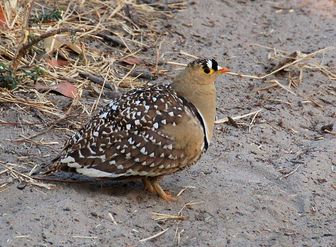Double-banded Sandgrouse

Original source: Own work
Author: Marie de Carne
Permission: GNU Free Documentation License
The Double-banded Sandgrouse is classified as Least Concern. Does not qualify for a more at risk category. Widespread and abundant taxa are included in this category.
The Double-banded Sandgrouse (Pterocles bicinctus) is a species of bird in the Pteroclididae family. It is found in Angola, Botswana, Malawi, Mozambique, Namibia, South Africa, Zambia, and Zimbabwe. References - * BirdLife International 2004. Pterocles bicinctus. 2006 IUCN Red List of Threatened Species. Downloaded on 24 July 2007. More
The Double-banded Sandgrouse is a Southern African bird that belongs to the Pteroclidae bird family group which includes birds such as Sandgrouse. The description for the Double-banded Sandgrouse (Latin name Pterocles bicinctus) can be found in the 7th Edition of the Roberts Birds of Southern Africa. The Pterocles bicinctus can be quickly identified by its unique Roberts identification number of 347 and the detailed description of this bird is on page 340. More
Distribution of Double-banded sandgrouse in southern Africa, based on statistical smoothing of the records from first SA Bird Atlas Project (© Animal Demography unit, University of Cape Town; smoothing by Birgit Erni and Francesca Little). Colours range from dark blue (most common) through to yellow (least common). See here for the latest distribution from the SABAP2. Pterocles bicinctus (Double-banded sandgrouse) Double-banded sandgrouse clutch, Ruacana, Namibia. More
The Double-banded Sandgrouse (Pterocles bicinctus) is widespread and fairly common across much of the arid regions of southern Africa. The top image was taken in the Huab River Valley, Namibia, in October, 1998, with a Canon EOS 1N and EF 300mm F/2.8 L lens and 2X extender on Fuji Sensia film. The next image was taken in Etosha National Park, Namibia, in October, 1998, with the same equipment. More
page 340 also a picture of the Double-banded Sandgrouse on page 321. The Double-banded Sandgrouse belongs to the family of birds classified as Pteroclidae. Image shows female. The map of the Kruger you see on this page shows the areas (coloured orange) where this bird has been identified. The basic information was provided by the Avian Demographic Unit based at UCT and I created the maps from that information ... More
View all pictures of Double-banded Sandgrouse View all pictures of Double-banded Sandgrouse show section External Links (0) We currently have no external links for this species. More
Two African examples are the Double-banded Sandgrouse of south Africa (above left) and the Black-faced Sandgrouse of east Africa (above right; a fine shot by Dale & Marian Zimmerman as my own photos of this bird don't come close to matching theirs). One special feature of sandgrouse is their long flights to water holes in desert and semi-desert country where not only do they drink, but during breeding they wet their belly feathers to carry water to the chicks. More
Double-banded Sandgrouse and Pearl-breasted Swallow visited the nearby waterholes. Our first Kalahari Scrub Robin was seen further afield and a night drive turned up Rufous-cheeked Nightjar, with three individuals captured and ringed by Steve. The nocturnal mammals were even more impressive and we saw, in short succession, Bat-eared Fox, Cape Fox and Striped Polecat. Other mammals seen were a pride of Lion, Hartmann’s Mountain Zebra and the scarce Black Mongoose. More

Original source: Dave Govoni
Author: Dave Govoni
Permission: Some rights reserved
Family : Pteroclididae
Genus : Pterocles
Species : bicinctus
Authority : Temminck, 1815

